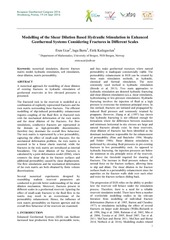Modelling of the Shear Dilation Based Hydraulic Stimulation in Enhanced Geothermal Systems Considering Fractures in Different Scales
Conference lecture
Published version

Åpne
Permanent lenke
https://hdl.handle.net/1956/17513Utgivelsesdato
2016-09Metadata
Vis full innførselSamlinger
Sammendrag
A numerical approach for modelling of shear dilation of existing fractures in hydraulic stimulation of geothermal reservoirs at low elevated pressures is presented. The fractured rock in the reservoir is modelled as a combination of explicitly represented fractures and the rock matrix surrounding these fractures. The efficient modelling of slip-induced permeability enhancement requires coupling of the fluid flow in fractured rock with the mechanical deformation of the rock matrix and the shear dilation of the fractures. For flow simulations, conductive fractures are represented in the domain as high-permeable discontinuities; therefore they dominate the overall flow behaviour. The rock matrix is represented by a low permeability, capturing the effect of small-scale fractures. For the mechanical deformation problem, the rock matrix is assumed to be a linear elastic material, while the fractures in the rock matrix are introduced as internal boundaries. The shear dilation of the fractures is calculated by a joint deformation model (JDM), which connects the shear slip in the fracture surfaces and additional permeability caused by shear displacement. The flow simulations and the mechanical deformation of the rock matrix are both obtained by finite volume discretizations. Several numerical experiments designed by resembling realistic reservoir parameters are conducted to provide better understanding of the shear dilation mechanism. Moreover, fractures present in different scales in a geothermal reservoir. Ignoring the effect of small-scale fractures to the fluid flow in the matrix may result in an overestimate of the permeability enhancement. Hence, the influence of rock matrix permeability on fracture aperture and the overall flow behaviour of the reservoir are examined.